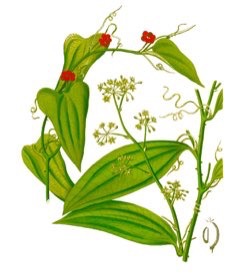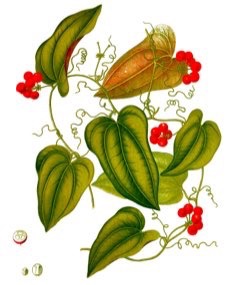 |
|
http://www.edibleplants.org |
 |
| http://www.edibleplants.org |
Translate this page:
Summary
Mexican Sarsaparilla, Smilax aristolochiifolia, is a perennial climbing plant native to Mexico and Central America. It is also known as gray sarsaparilla or sarsaparilla. Its leaves are ovate, paper-like, leathery, and alternate. The fruits are small red berries with 2 or 3 seeds. The flowers are small and green, readily symmetrical, and dioecious. S. aristolochiifolia is medicinally used against inflammation, itching, digestive problems, fevers, kidney disorders, gonorrhea, scrofulous, skin diseases, and rheumatism. Root extracts are used as flavoring in beverages, ice cream, confectioneries, and bakery products.
Physical Characteristics

 Smilax aristolochiifolia is an evergreen Perennial Climber growing to 5 m (16ft) by 0.5 m (1ft 8in) at a fast rate.
Smilax aristolochiifolia is an evergreen Perennial Climber growing to 5 m (16ft) by 0.5 m (1ft 8in) at a fast rate.
See above for USDA hardiness. It is hardy to UK zone 10.
Suitable for: light (sandy), medium (loamy) and heavy (clay) soils and prefers well-drained soil. Suitable pH: mildly acid, neutral and basic (mildly alkaline) soils. It can grow in semi-shade (light woodland) or no shade. It prefers moist soil.
UK Hardiness Map
US Hardiness Map
Synonyms
Smilax kerberi F.W.Apt Smilax medica Schltdl. & Cham.
Plant Habitats
Edible Uses
Edible Parts: Root
Edible Uses: Condiment
Root extracts are used to flavour soft drinks ice cream, confectionery and bakery products[238 , 301 ]. A bitter, liquorice-like root[301 ].
References More on Edible Uses
Medicinal Uses
Plants For A Future can not take any responsibility for any adverse effects from the use of plants. Always seek advice from a professional before using a plant medicinally.
Acrid Alterative Antiinflammatory Antirheumatic Antiseptic Digestive Febrifuge Kidney
Skin
Mexican sarsaparilla (the roots and rhizome) is a sweet, acrid, alterative herb that reduces inflammation, controls itching, improves digestion and elimination and is antiseptic[238 ]. This is one of three species (the others are S. Febrifuga and S. Regelii) that gained a high reputation in the 17th century as cure-alls[238 ]. They were widely imported into Europe until early in the 20th century, by which time their rather overrated reputation had waned somewhat. However, the plants do have a number of important medicinal benefits - in particular, their roots contain steroidal saponins which are an effective treatment for many cases of psoriasis; they also have hormonal effects, and may improve fertility in women with ovarian dysfunction[238 ]. The rhizomes are alterative, digestive, febrifuge[46 , 238 ]. A decoction is used in the treatment of fevers, digestive disorders, kidney troubles and gonorrhoea[46 ]. It is also used against scrophulus, skin diseases and rheumatism[46 ].
References More on Medicinal Uses
The Bookshop: Edible Plant Books
Our Latest books on Perennial Plants For Food Forests and Permaculture Gardens in paperback or digital formats.

Edible Tropical Plants
Food Forest Plants for Hotter Conditions: 250+ Plants For Tropical Food Forests & Permaculture Gardens.
More

Edible Temperate Plants
Plants for Your Food Forest: 500 Plants for Temperate Food Forests & Permaculture Gardens.
More

More Books
PFAF have eight books available in paperback and digital formats. Browse the shop for more information.
Shop Now
Other Uses
Other Uses: None known
Special Uses
References More on Other Uses
Cultivation details
References Carbon Farming Information and Carbon Sequestration Information
Temperature Converter
Type a value in the Celsius field to convert the value to Fahrenheit:
Fahrenheit:
The PFAF Bookshop
Plants For A Future have a number of books available in paperback and digital form. Book titles include Edible Plants, Edible Perennials, Edible Trees,Edible Shrubs, Woodland Gardening, and Temperate Food Forest Plants. Our new book is Food Forest Plants For Hotter Conditions (Tropical and Sub-Tropical).
Shop Now
Plant Propagation
Seed -
Other Names
If available other names are mentioned here
american sarsaparilla, gray sarsaparilla, mexican sarsaparilla, mexiko-sarsaparille, salsapariglia smilace, salsaparrilha, salsaparrilha de minas de gerais, salsaparrilha do mexico, salsaparrilha do para, salsepareille, salsepareille du mexique, sarsaparilla, sarsaparilla radix, ushba, ushba maghrabi, vera cruz sarsaparilla, veracruz sarsaparilla, wild liquorice, zarzaparilla.
Native Range
NORTHERN AMERICA: Mexico (Tabasco, Veracruz de Ignacio de la Llave, Yucatán) SOUTHERN AMERICA: Belize, Guatemala
Weed Potential
Right plant wrong place. We are currently updating this section.
Please note that a plant may be invasive in one area but may not in your area so it's worth checking.
Conservation Status
IUCN Red List of Threatened Plants Status : This taxon has not yet been assessed

Growth: S = slow M = medium F = fast. Soil: L = light (sandy) M = medium H = heavy (clay). pH: A = acid N = neutral B = basic (alkaline). Shade: F = full shade S = semi-shade N = no shade. Moisture: D = dry M = Moist We = wet Wa = water.
Now available:
Food Forest Plants for Mediterranean Conditions
350+ Perennial Plants For Mediterranean and Drier Food Forests and Permaculture Gardens.
[Paperback and eBook]
This is the third in Plants For A Future's series of plant guides for food forests tailored to
specific climate zones. Following volumes on temperate and tropical ecosystems, this book focuses
on species suited to Mediterranean conditions—regions with hot, dry summers and cool, wet winters,
often facing the added challenge of climate change.
Read More
Expert comment
Author
Mill.
Botanical References
Links / References
For a list of references used on this page please go here
A special thanks to Ken Fern for some of the information used on this page.
Readers comment
| Add a comment |
|
If you have important information about this plant that may help other users please add a comment or link below. Only comments or links that are felt to be directly relevant to a plant will be included. If you think a comment/link or information contained on this page is inaccurate or misleading we would welcome your feedback at [email protected]. If you have questions about a plant please use the Forum on this website as we do not have the resources to answer questions ourselves.
* Please note: the comments by website users are not necessarily those held by PFAF and may give misleading or inaccurate information.
To leave a comment please Register or login here All comments need to be approved so will not appear immediately.
|
Subject : Smilax aristolochiifolia
|
|
|
|